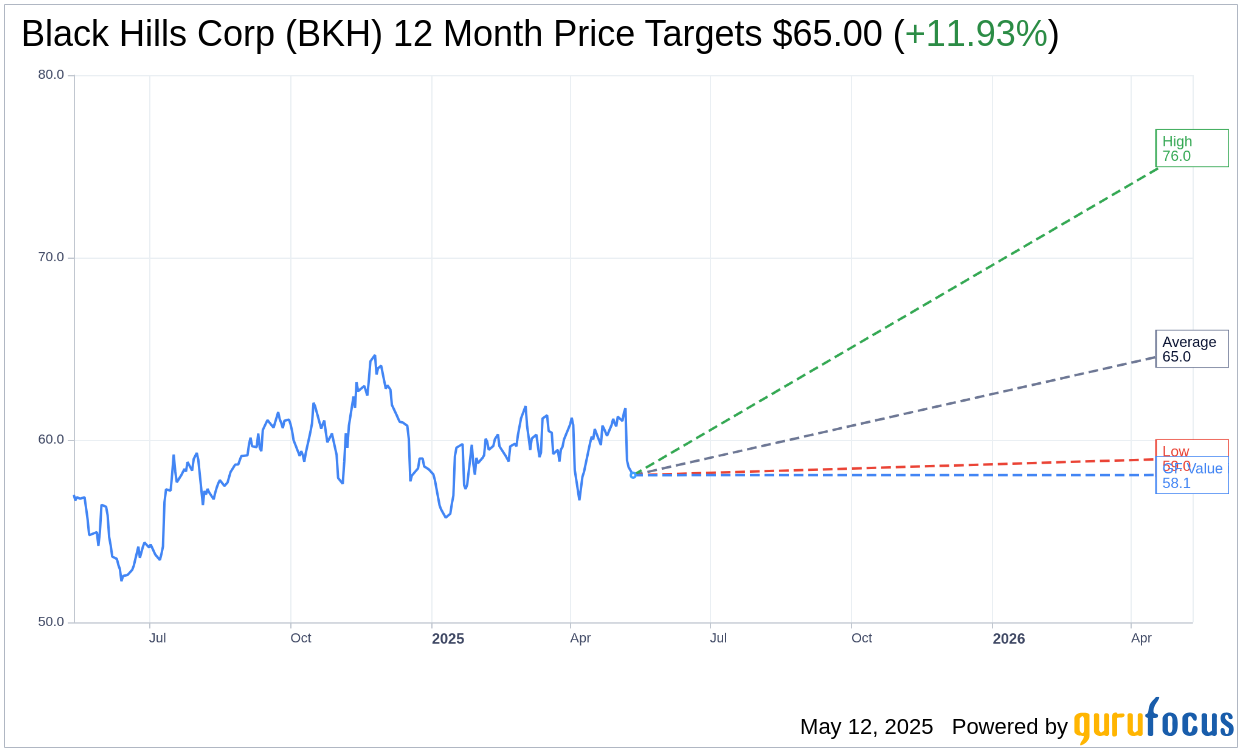BMO Capital has started its coverage of Black Hills (BKH, Financial) by giving it an Outperform rating, alongside setting a price target of $68. The firm views the current trading price as significantly undervalued, noting that BKH shares are priced 20%-21% lower than similar companies, despite its strong attributes that could lead to future outperformance.
Black Hills stands out due to its appealing valuation relative to competitors, a growth strategy centered on regulation, and a robust financial slate. The company also boasts above-average growth in its rate base and potential benefits from increased capital expenditure. These factors contribute to BMO Capital's optimistic outlook on the stock.
Wall Street Analysts Forecast

Based on the one-year price targets offered by 5 analysts, the average target price for Black Hills Corp (BKH, Financial) is $65.00 with a high estimate of $76.00 and a low estimate of $59.00. The average target implies an upside of 11.93% from the current price of $58.07. More detailed estimate data can be found on the Black Hills Corp (BKH) Forecast page.
Based on the consensus recommendation from 5 brokerage firms, Black Hills Corp's (BKH, Financial) average brokerage recommendation is currently 2.8, indicating "Hold" status. The rating scale ranges from 1 to 5, where 1 signifies Strong Buy, and 5 denotes Sell.
Based on GuruFocus estimates, the estimated GF Value for Black Hills Corp (BKH, Financial) in one year is $58.08, suggesting a upside of 0.02% from the current price of $58.07. GF Value is GuruFocus' estimate of the fair value that the stock should be traded at. It is calculated based on the historical multiples the stock has traded at previously, as well as past business growth and the future estimates of the business' performance. More detailed data can be found on the Black Hills Corp (BKH) Summary page.
BKH Key Business Developments
Release Date: May 08, 2025
- Earnings Growth: 5% year-over-year growth target reaffirmed.
- EPS Guidance: 2025 earnings guidance range of $4 to $4.20.
- New Margins: $0.29 per share, with $0.26 from new rate and rider recovery and $0.03 from customer growth and usage.
- Capital Plan: $1 billion investment for the year; $4.7 billion over five years through 2029.
- Equity Issuance: $215 million to $235 million planned for 2025; $46 million issued in Q1.
- Liquidity: Nearly $700 million available under revolving credit facility.
- Dividend Track Record: 55 consecutive years, targeting a 55% to 65% payout ratio.
- Data Center Demand: Expected to reach 500 megawatts by 2029; EPS contribution to double by 2028.
- Rate Reviews: New rates implemented in Colorado; ongoing reviews in Kansas and Nebraska.
- Weather Impact: Favorable by $0.11 of EPS year-over-year due to colder winter.
- O&M Expenses: Increased by $0.24, driven by employee costs, outside services, and insurance.
For the complete transcript of the earnings call, please refer to the full earnings call transcript.
Positive Points
- Black Hills Corp (BKH, Financial) is making excellent progress toward its key objectives, including a 5% year-over-year earnings growth and executing a $1 billion capital plan.
- The company has successfully implemented new rates through five rate reviews since the beginning of 2024, reflecting the recovery of more than $1.3 billion of new system investments.
- Strong customer growth is evident, with new all-time customer peak loads at Wyoming Electric driven by data center and blockchain growth.
- The Ready Wyoming transmission expansion project is on schedule, with the first phase providing material investment recovery.
- Black Hills Corp (BKH) has a robust balance sheet and strong confidence in its long-term EPS growth target of 4% to 6%.
Negative Points
- Higher O&M expenses were reported, driven by increases in employee costs, outside services, and insurance costs.
- The company is facing challenges with regulatory decisions, such as the Colorado electric rate case where the awarded equity ratio was lower than requested.
- There are potential delays in data center expansion plans by key customers like Microsoft, which could impact future growth.
- The company is managing higher interest expenses and additional depreciation costs, which offset some of the positive margins.
- Insurance costs remain a concern, with ongoing efforts to manage and recover these costs through rate reviews.
